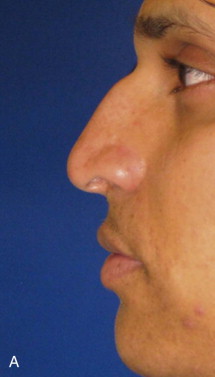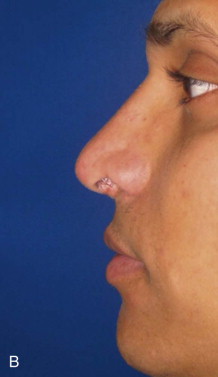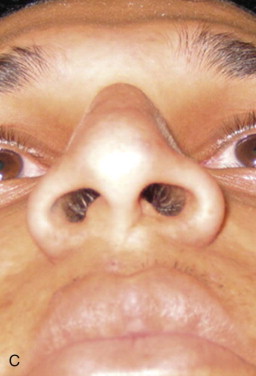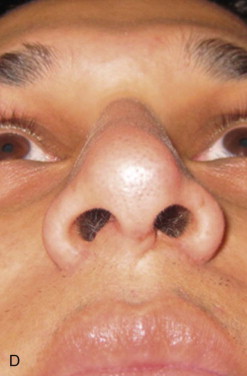Armamentarium
|
History of the Procedure
Historically, rhinoplasty involved more nasal reconstruction than is now used in contemporary techniques. It is believed that as early as 1600 bc , Egyptians were performing various types of nasal surgery and manipulations. Indian physician Sushruta Samhita, who lived around 1000 to 800 bc , is also recognized as one of the pioneers of rhinoplasty. In 1818, German surgeon Carl van Graefe used the term rhinoplasty for the first time in his textbook. Other prominent surgeons, such as Johann Dieffenbach, John Roe, and Robert Weir, made significant contributions to the art of rhinoplasty in the middle to late nineteenth century. However, the father of modern rhinoplasty is considered to be Dr. Jacques Joseph (1865-1934), an orthopedic surgeon from Berlin who performed a rhinoplasty using “external incisions” in 1898. Three surgeons, Joseph Safian, Gustave Aufricht, and Samuel Fomon, traveled to Europe to learn Joseph’s techniques, and these three men were instrumental in bringing rhinoplasty to the United States in the 1940s. Two of Fomon’s students, Irving Goldman and Maurice Cottle, became leaders in the field of rhinoplasty in the second half of the twentieth century. They also were instrumental in developing various surgical and rhinoplastic societies in the United States. Other notable surgeons involved in enhancing the art of rhinoplasty in this country include Jack Anderson, Richard Webster, Gaylon McCullough, and Jack Gunter. Anderson is considered the first person to perform an open rhinoplasty, in the early 1980s.
History of the Procedure
Historically, rhinoplasty involved more nasal reconstruction than is now used in contemporary techniques. It is believed that as early as 1600 bc , Egyptians were performing various types of nasal surgery and manipulations. Indian physician Sushruta Samhita, who lived around 1000 to 800 bc , is also recognized as one of the pioneers of rhinoplasty. In 1818, German surgeon Carl van Graefe used the term rhinoplasty for the first time in his textbook. Other prominent surgeons, such as Johann Dieffenbach, John Roe, and Robert Weir, made significant contributions to the art of rhinoplasty in the middle to late nineteenth century. However, the father of modern rhinoplasty is considered to be Dr. Jacques Joseph (1865-1934), an orthopedic surgeon from Berlin who performed a rhinoplasty using “external incisions” in 1898. Three surgeons, Joseph Safian, Gustave Aufricht, and Samuel Fomon, traveled to Europe to learn Joseph’s techniques, and these three men were instrumental in bringing rhinoplasty to the United States in the 1940s. Two of Fomon’s students, Irving Goldman and Maurice Cottle, became leaders in the field of rhinoplasty in the second half of the twentieth century. They also were instrumental in developing various surgical and rhinoplastic societies in the United States. Other notable surgeons involved in enhancing the art of rhinoplasty in this country include Jack Anderson, Richard Webster, Gaylon McCullough, and Jack Gunter. Anderson is considered the first person to perform an open rhinoplasty, in the early 1980s.
Indications for the Use of the Procedure
Septoplasty and rhinoplasty are indicated in the management of functional and cosmetic deformities of the nasal complex. Often combined, these procedures are aimed at correcting various nasal airflow obstructions along the nasal complex and improving the appearance of the external nose ( Figure 137-1 ). An isolated septoplasty addresses nasal deviation and breathing difficulties. Rhinoplasty can improve the appearance of the nose. When the two procedures are performed together, graft material can be obtained through septoplasty that can be used during the rhinoplasty portion of the operation. Essentially, all aspects of the nose or septum can be approached and modified through two main techniques: an open technique or a closed, or endonasal, technique. Minor modifications of the nose can be approached through the closed technique, whereas the open technique is reserved for a more comprehensive and direct approach. The term “open structure rhinoplasty” describes an open rhinoplasty procedure in which procured grafts (from septoplasty) are used to structure or build a nose.




Limitations and Contraindications
Septorhinoplasty has few limitations. Patients who have radiographically proven maxillary sinus disease (e.g., polyps) may not benefit from an isolated septoplasty or rhinoplasty. It is prudent to differentiate between patients who have difficulty breathing because of sinus disease and those who have difficulty breathing because of a deviated nasal complex or those with allergy-mediated processes (e.g., allergic rhinitis). A contraindication to a cosmetic rhinoplasty is any psychiatric disorder, such as body dysmorphic disorder, in which the patient has unrealistic expectations.
Technique: Open Rhinoplasty with Septoplasty
Step 1:
Preparation of Nose
The surgery is performed with the patient under general anesthesia. After an oral endotracheal tube has been secured, a throat pack is placed. A local anesthetic with a vasoconstrictor is injected into the nose, specifically along the caudal edge of the lateral crus, columella, dome, and lateral nasal walls. The septum should also be injected between the cartilage and nasal mucosa on both sides. The nose is packed with cottonoid soaked in oxymetazoline and then prepped and draped for surgery. This sequence allows ample time to obtain vasoconstriction of the nose before the incision is made.
Step 2:
Incision
Stay updated, free dental videos. Join our Telegram channel

VIDEdental - Online dental courses


